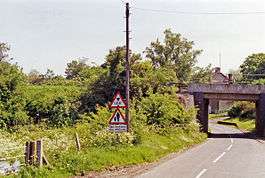Fritwell & Somerton railway station
Fritwell & Somerton railway station was on the Oxford to Banbury line of the Great Western Railway,[1] and was opened four years after the line, in September 1854.[2] It was in the village of Somerton, Oxfordshire.
| Fritwell & Somerton | |
|---|---|
 Site of the station in 1992 | |
| Location | |
| Place | Somerton |
| Area | Oxfordshire |
| Coordinates | 51.956°N 1.279°W |
| Grid reference | SP496289 |
| Operations | |
| Original company | Great Western Railway |
| Pre-grouping | Great Western Railway |
| Post-grouping | Great Western Railway |
| Platforms | 2 |
| History | |
| 2 September 1850 | Line opened from Oxford to Banbury |
| 1855 | Station opened as Somerton |
| 2 July 1906 | renamed Somerton Oxon |
| 1 October 1907 | renamed Fritwell & Somerton |
| 2 November 1964 | Station closed |
| Disused railway stations in the United Kingdom | |
| Closed railway stations in Britain A B C D–F G H–J K–L M–O P–R S T–V W–Z | |
History
The line had been authorised as the Oxford and Rugby Railway, but had been absorbed by the GWR prior to its opening on 2 September 1850. No station was originally planned at Somerton — the nearest station to the village was Heyford, three miles to the south.[3] The station at Aynho for Deddington was closer by rail, being about 2.5 miles (4 km) to the north, but the road journey was about 5 miles (8 km).
It was soon decided that Somerton needed a station. It was built south of the railway bridge in the village, and opened in 1855, being originally named Somerton.[3][4]
A station at Somerton (Somerset) was opened on 2 July 1906,[5][4] and to avoid confusion, the Oxfordshire station was renamed twice: first to Somerton Oxon also on 2 July 1906,[4] then to Fritwell & Somerton on 1 October 1907,[6][7] although the village of Fritwell is 2 miles (3 km) away.
The goods service was withdrawn on 4 May 1964,[8] and the passenger service ceased on 2 November 1964.[9][10][2]
Route
| Preceding station | Historical railways | Following station | ||
|---|---|---|---|---|
| Aynho for Deddington Line open, station closed |
Great Western Railway Oxford and Rugby Railway |
Heyford Line and station open | ||
Notes
- Conolly 1976, p. 10, section D4.
- Simpson 1997, p. 93.
- MacDermot 1927, p. 300.
- Butt 1995, p. 214.
- MacDermot 1931, p. 433.
- Butt 1995, pp. 100,214.
- Mitchell & Smith 2003, figure XX.
- Mitchell & Smith 2003, figure 90.
- Butt 1995, p. 100.
- Railway Magazine, December 1964, p.920
References
- Butt, R. V. J. (1995). The Directory of Railway Stations: details every public and private passenger station, halt, platform and stopping place, past and present (1st ed.). Sparkford: Patrick Stephens Ltd. ISBN 978-1-85260-508-7. OCLC 60251199.
- British Railways Pre-Grouping Atlas and Gazetteer (Map) (5th ed.). 1" = 8 miles. Cartography by W. Philip Conolly. Ian Allan. 1976. ISBN 0-7110-0320-3.
- MacDermot, E.T. (1927). History of the Great Western Railway. Vol. I (1st ed.). Paddington: Great Western Railway.CS1 maint: ref=harv (link)
- MacDermot, E.T. (1931). History of the Great Western Railway. Vol. II (1st ed.). Paddington: Great Western Railway.CS1 maint: ref=harv (link)
- Mitchell, Vic; Smith, Keith (February 2003). Didcot to Banbury. Western Main Lines. Midhurst: Middleton Press. ISBN 1-904474-02-0.CS1 maint: ref=harv (link)
- "Services withdrawn by L.M.R.". Railway Magazine. Westminster: Tothill Press. 110 (764). December 1964.
- Simpson, Bill (1997). A History of the Railways of Oxfordshire. Part 1: The North. Banbury and Witney: Lamplight. ISBN 1-899246-02-9.CS1 maint: ref=harv (link)
- Waters, Lawrence (1986). Oxford. Rail Centres. London: Ian Allan. ISBN 0-7110-1590-2.CS1 maint: ref=harv (link)